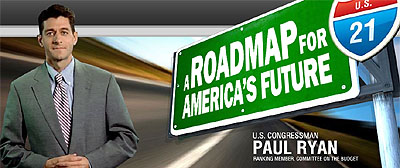I complained yesterday that Paul Ryan’s “Roadmap for America’s Future” was a fraud: it doesn’t really tell us where he’d cut spending, it just places arbitrary caps on  various kinds of spending and calls it a day. Ezra Klein says I’m being unfair:
various kinds of spending and calls it a day. Ezra Klein says I’m being unfair:
That’s how single-payer works, too: It puts health-care spending into a single budget and caps its increase. That’s how the Clinton plan worked, what with its global budgets and premium caps. That’s how Jacob Hacker’s plan for the Economic Policy Institute worked: Inside the exchanges, spending could only grow by GDP plus one percentage point. That’s how the strong public option would’ve worked, as payment could only grow using Medicare’s formula, which doesn’t permit the cost increases of the private market.
At the end of the day, that’s why Ryan’s plan is a more honest entry into the debate. For a long time, liberals were talking about the sort of things you would actually have to do to get health-care spending under control while conservatives simply criticized the downsides of those intimidating reforms. And the main thing you have to do is get health-care spending into a single budget and then stick to it.
Fair enough. There’s still the fact that Ryan doesn’t really fess up to cutting Social Security payouts, doesn’t provide any hint about how he’d cut discretionary spending, and proposes a new tax system that’s wildly beneficial to the rich. But on healthcare costs, Ezra’s point is fair enough.
Up to a point, that is, because there is still a difference. In a single-payer system, there’s a pretty good theory about how costs are held down: by using the market power of the government to negotiate lower prices for drugs, devices, medical services, and so forth. What’s more, we have the experience of dozens of single-payer systems in other countries to suggest that this works. Plus there’s the fact that a single-payer system explicitly gives some government entity the job of deciding which medical services are covered and which aren’t. Not everyone likes this idea, but it’s there.
Ryan’s plan, by contrast, doesn’t do any of this. There’s not even much of a theory about how it will hold down costs. It simply writes a check to Medicare recipients and then tells them to cut the best deal they can with any approved private supplier. This might work, but I can’t really think of a lot of real-world examples where something like this has worked — especially since the bulk of the non-Medicare healthcare system is left unaffected by Ryan’s plan. More likely, medical costs will continue to rise and Medicare recipients will either have to settle for crappy service or else simply pony up a whole lot of out-of-pocket expenses on their own.
Needless to say, not everyone likes this idea either. Let’s be clear: we’ve given the private market many decades to show that it can make medical care more efficient and less costly. In theory, this ought to work, but in practice it’s failed miserably. Conversely, single-payer plans have a demonstrated track record of providing high quality service while keeping costs well below what we pay in America. That’s because single-payer systems have an actual mechanism for controlling costs. You can decide for yourself if you like that mechanism, but it’s there. Ryan’s plan, by contrast, doesn’t have one and most likely won’t control costs at all. It will just force Medicare recipients to pay an ever larger part of the bill. Your choice.













